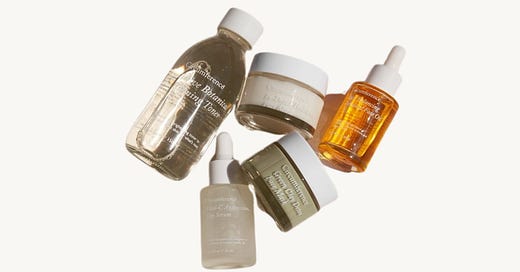an amateur's guide to retinol
An explanation to the Vitamin A-game and the plethora of "tret-to-ret" options out there (including the plant based ones that get the same results). PS - I made diagrams.
Updated from 2024, I thought I’d reshare this as my following has grown a lot since originally posting. I’ve had lots of messages from women who seem to be starting a retinol journey as a New Year kick, so here is all the research I did, what I’ve learnt and what I’d recommend.
As I stumbled into my thirties I found skincare conversation between friends had developed from, “do you still use face wipes?” towards, “what are you using for anti aging?”. I was beginning to try products out and the word “retinol” kept coming up, with much consumer trepidation. This mystical ingredient that you could only use at night and could only get the good stuff abroad… I laugh at myself now for being hesitant, Vitamin A is just another ingredient in the world of beauty. However, it does take a *little* more thought than others as it can cause the skin to react (sometimes meaning it’s doing its job).
I’m not a dermatologist and I have no formal training, but here is my amateur opinion on the good products I’ve tried and my understanding of how it all works.
When it comes to the different types, I was just as confused as you probably are. It used to be really simple in that if you used retinol in the UK you could get a strength of up 0.5% in regular stores. If you used retinol in the US or a few other places it could climb up to 1%. You could get stronger strengths from dermatologists, up to 3%. This level of information I could handle.
Then the word “retinoid” came up. Followed by “retinal”. Then “phyto retinol”. They sound the same, but they aren’t. Retinoid is the umbrella term for “retinols” (available over the counter) and “tretinoin” which is prescription strength. So, a “tretinoin” is a “retinoid” but isn’t a “retinol.” Still with me? Because next comes the idea of “the Vitamin A pathway” which explains the stages of retinol and how it is absorbed by your skin.
Retinols become retinals, which in turn become retinoids (retinoic acid). It’s at this stage the ingredients become ‘active’ and visible results begin to occur. Below is a little guide I made and don’t worry I’ll guide you through it all.
So in simple terms; retinols are the weakest option in the retinol family - but - they have the most work to do to become useful to the skin (ie: become a retinoid that does the work for your skin). Retinals are faster working as they are further along the conversion pathway - but - they are less stable and therefore can cause a reaction if not formulated (and used) carefully. Retinoids are the most potent and speed-driven - but - by far the strongest and most likely to cause a reaction. A product with 1% retinoid is infinitely stronger than a product with 1% retinol (as an example).
In my mind, brands that produce retinals and retinoid based products really need to know what they are doing - and you as a consumer need to know what else to look for in a formulation that means it will work for your skin. A well formulated product with 0.05% retinol will give you better results than a bad one with 1% retinal.
How Do Retinols Work?
Figuring out how retinols work can take a while, but here is my overarching interpretation: Retinols remove dead cells (exfoliate) and encourage cells clinging on to go (hence shedding) leaving behind a buffed, newer top layer of skin. This top layer is more sensitive to light (like the “retina” in your eye) hence the need to wear SPF during the day if you’re using this ingredient. Retinols are typically used at night for two reasons. Firstly, there is no danger of light exposure when the product is at its most potent. Secondly, because our skin does the most healing/fixing at night while we sleep.






